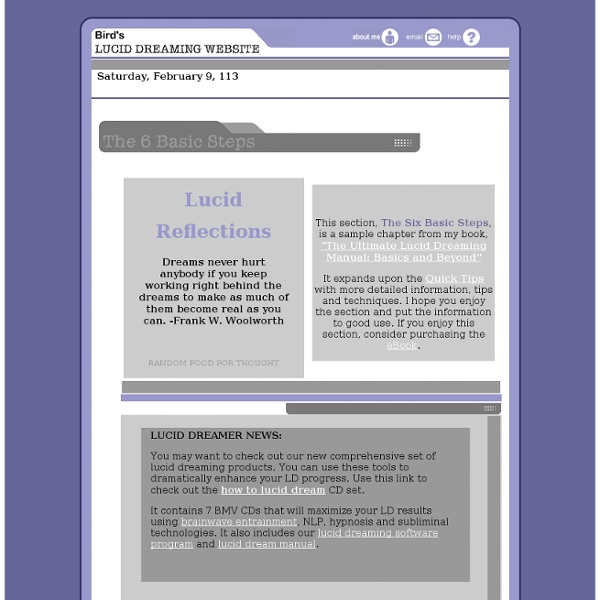Lucid Dreaming Tips - How to Lucid Dream - Tips for Lucid Dreaming / Lucid Dreams

Advanced Lucid Dreaming Techniques
This article is useful for the experienced dreamer who wishes to refine and deepen their lucid adventures. If you’ve never practiced being consciously aware within your dreams, check out the beginner lucid dreaming article. To make the following techniques effective I suggest you maximize your dream recall ability. Two weeks worth of daily dream entries in your journal would be advantageous. In-Dream Objectives Gather ‘Chi’ Energy You don’t have to be a Chi-Gong master to accomplish this! Breakdown the Dream Wall When Lucid, preferably after grounding, state your date of birth and the place of where you were born. Advanced Dream Recall When grounded in lucidity, boost your dream memory by stating out loud with eyes open the following: “I will remember all that there is to remember”. Meditate within the Dream World I discovered this intuitively a few years back. Call Out For Your Spirit Guide Become Lucid and find a dream character and ask three times, “Are you my Spirit Guide?” 5 HTP-100mg
MyLifeIsAverage - Life is pretty normal today
Top 10 tips on how to lucid dream « How To Lucid Dream
digg For those of you who like to get straight to the good stuff, I’ve compiled a list of the top 10 tools that you can use to learn how to lucid dream. These are so good that you probably won’t need to use any more than two or three before you start having some degree of lucidity. 1. Napping during the day not only means you’ll be less tired (increasing likelihood of lucid dreams), but it gives you an extra chance to practice. 2. If you stumble through your waking life in a haze, make it a habit to take more notice of the external world. 3. Music has the ability to trigger just about any emotion you can think of. 4. Unless you snore heavily, a voice-activated tape recorder put on your bedside table will be able to record any sounds you make during the night. 5. Consuming foods with strong flavors or spices has an interesting effect on the body, just as taking some drugs or medications can do. “The Dream” – Pablo Picasso (1932) 6. 8. Wake yourself up during the night. 9. 10. Like this:
Dear blank, please blank.
Tutorial for Saying a Mantra
Hi i'm LucidAvenger Many people have heard the word 'mantra' floating around DV but not many people actually know what it is and how to do one. In this tutorial I will explain what a mantra is; the requirements for a mantra; creating your own mantra, examples of mantras, when and how to say a mantra. The tutorial is fairly long for just a mantra and if you do not have time to read the whole thing then I reckon you just need to read: when and how to say a mantra and requirements for a mantra :) What is a Mantra? A mantra is basically an affirmation in which you try to hammer a phrase into your head. The phrase is usually something that convinces your mind of something. Dream RecallDEILD MethodLucid Dreaming Through MILDWaking Up During the NightDream TasksDream Incubation The mantra is used to get a thought or an idea into the subconscious, which later 'remembers' or is 'affirmed' about the task. Requirements for a Mantra Firstly, always use a mantra that is in present tense.
BellaNessieCullen's FanFiction
EWLD6
[From: S. LaBerge & H. Rheingold, (1990).
Hypnagogia and Hypnopompia | The Dream Studies Portal
Hypnagogia is the imagery, sounds and strange bodily feelings that are felt at “sleep onset.” This is a simplification though, as researchers have noted hypnagogic imagery in the lab at periods of quiet wakefulness as well as stage 1 sleep. Others have correlated hypnagogia with pre-sleep alpha waves and also REM intrusion into sleep onset. The truth is that the wake-sleep transition is still not understood. And neither are its trippy visuals. whispy lights, multi-dimentional geometric objects, or a sudden image like a stranger’s face Few people remember hypnagogic imagery. Strange noises, voices and rushing sounds are typical, as well as weird mechanistic sounds like beeps and boops. Some hear music — I personally have had lucid hypnagogic orchestras from time to time, with the ability to listen passively or focus on a particular instrument to induce a solo. Entoptica - by Ryan Hurd, 2005, acrylic: inspired by my hypnagogic imagery Some people are haunted by the hypnagogic imagery.
Neuron : Temporally Structured Replay of Awake Hippocampal Ensemble Activity during Rapid Eye Movement Sleep
To view the full text, please login as a subscribed user or purchase a subscription. Click here to view the full text on ScienceDirect. Fig. 1 Behavioral Task and Hippocampal Unit Activity (A) Schematic of the four-trial sequence in the circular track task. A single trial consisted of travel from the start location to a removable food well placed at the goal location, followed by food consumption; in any given trial the goal was located at a position 270° clockwise from the start. (B) Spatial firing characteristics of three example CA1 cells. (C) Periodic repetition of characteristic ensemble spiking pattern. Fig. 2 Identification of REM Sleep Templates for Correlation Analysis (A) Experimental design. (B) Schematic of sliding window correlation analysis. Fig. 3 Example Correspondence between a REM Template and RUN Activity (Top) Rasters of 10 pyramidal cells during a 75 s window from RUN. . Fig. 4 Ensemble Pattern Shuffle Analyses (A) BIN shuffle. (B) COLUMN shuffle. (C) SWAP shuffle. Fig. 5
Related:
Related:



